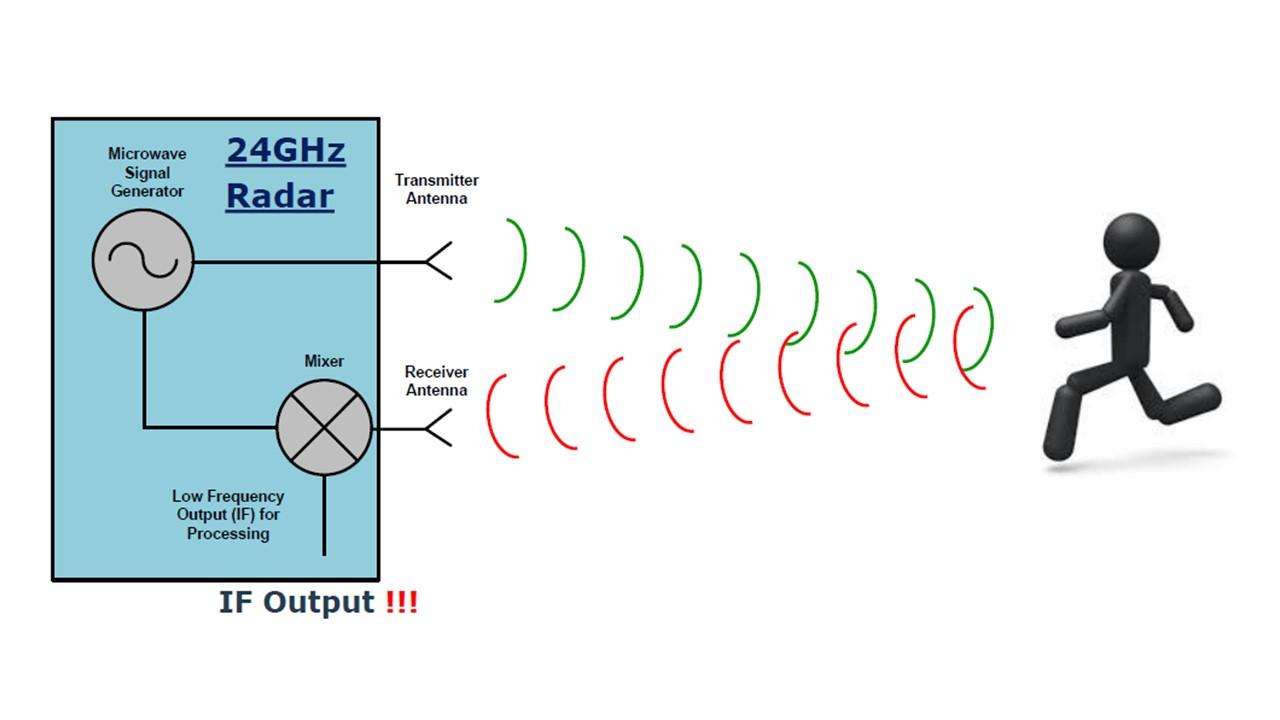What is millimeter wave radar?
Millimeter waves refer to electromagnetic waves with frequencies in the range of tens of GHz to hundreds of GHz. Millimeter-wave radar is a radar that uses millimeter-wave radio waves and can detect the distance, position information, and speed of an object with high accuracy. A millimeter-wave signal generated by a synthesizer is irradiated to an object, and various information can be obtained based on the radio waves that are reflected and returned.
In our daily lives, it is used in motion detection, heartbeat/breathing detection, gesture detection, and even in automobiles.

Two Reasons to Adopt Millimeter Wave Radar
Methods for measuring distance include infrared, ultrasonic, cameras, and ToF sensors. Here, we will explain two reasons for adopting millimeter-wave radar while comparing it with millimeter-wave radar.
Reason 1 Higher accuracy than infrared and ultrasonic methods
Infrared and ultrasonic sensors are generally used as the least expensive method of measuring distance.
However, since infrared and ultrasonic systems have high signal diffusion,
- low resolution
- short measurement distance
- Variation occurs due to environmental influences such as temperature
There are some disadvantages.
Millimeter-wave radar, which is a radio wave sensor, has high linearity and is not easily affected by the environment, so highly accurate measurement is possible. There is also the advantage that the antenna can be made smaller at 24 GHz.
Reason 2 Low cost and stable operation compared to camera and laser methods
There is also a method of adopting a camera or laser type sensor as a method of measuring distance with high accuracy. Since the camera and laser method have high straightness, high resolution and high accuracy measurement are possible.
but,
- High system cost due to high performance CPU and memory requirements
- It is greatly affected by the environment such as outside light, weather, and nighttime.
- Complex systems such as stereo cameras and ToF sensors
There are some disadvantages.
Millimeter-wave radar is highly stable against external light, weather, nighttime, and the environment, so highly reliable measurements are possible. In addition, since the antenna can be covered with a cover by using radio wave permeability, the degree of freedom in product design is high, and the measurement range and measurement accuracy can be controlled by the radar method, frequency, and antenna design.
The advantage of millimeter-wave radar is its good balance between performance and cost.
Application example
Such millimeter-wave radar is used in a variety of applications, both indoors and outdoors.
- drone
- smart form
- industrial robot
- street lamp
- Respiration/pulse sensing
- speedometer
- tank level meter
- Automatic door
- motion detection

Radar operating method
There are roughly three types of radar algorithms and operation methods, and the information that can be detected by each is different.
It can be selected according to the purpose and expanded to various applications.
Product Summary
Infineon offers a lineup of silicon germanium MMICs and millimeter wave radars for signal generation and reception that operate in the 24.0 to 26.0 GHz range so that users can select the most suitable product for their application. A high-frequency circuit can be integrated on a single chip, making it possible to measure speed, distance, and direction with high accuracy while maintaining a small size and low power consumption.
The features and specifications of each product are as follows.
|
BGT24MTR11 E6327 |
BGT24LTR11N16 |
BGT24LTR22 |
|
|
feature |
Low Phase Noise VCO with Temperature Compensation Circuit Switchable prescaler for 1.5GHz and 23kHz outputs On-chip power supply and temperature sensor, low power consumption Single-ended RF and LO terminals |
||
|
Standard goods |
Low power consumption product |
Multi-channel product (RX x 2/TX x 2) |
|
|
Low noise figure NFssb |
12dB |
10dB |
8db |
|
high conversion gain |
26dB |
20dB |
25dB |
|
High 1dB input compression point |
-12dBm |
-28dBm |
-19dBm |
|
Package |
VQFN 32pin (5.5mm x 4.5mm) |
TSNP-16-9 (2.4mm x 2.4mm) |
WFWLB-52-3 pin (3.63mm x 3.63mm) |
|
Single supply voltage |
3.3V |
3.3V |
1.5V |
|
power consumption |
500mW |
300mW |
500mW |
What is 60GHz radar?
Click here to purchase products
BGT24LTR22
*Radio Law certified modules are provided by the following partners.
Click here for manufacturer site/other related links
24GHz Radar Module Evaluation Kit
24GHz Radar Demo Kit Ver.2
Distance2Go development kit
Product introduction video
24GHz Radar (BGT24MTR11) Demonstration with SDH's Algorithm
This is a demonstration video of distance measurement, respiration detection, and heartbeat detection using Infineon Radar.
Working on Infineon 24GHz Radar
Infineon's FAE (Field Application Engineer) introduces 24GHz Radar technology and features, and a video about Infineon's development efforts.
Inquiry
If you have any questions about this product, please feel free to contact us.
Infineon manufacturer information top page
If you want to return to Infineon manufacturer information top page, please click below.
